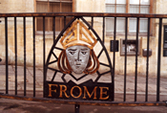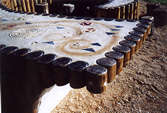
Design Approach - Site-specific work
As
a starting point for design I look at the site, the surrounding landscape
and environment, and the functional requirements. Having got a feel for
the site, and the practical necessities, I like to look at the historical
references of the area, and of the site, then consider the present condition,
along with future plans and aspirations
This stage of design research often involves talking to all kinds people
about how they see the area, how they can and do, or would like to use
the area, and from this I build up a set of images from which to work.
I feel that it is important to take into account the practical and functional,
as well as the aesthetic. The final design could draw on historical references,
the landscape, and the vision for the future which has been invested in
the site - but not always in an obvious or direct manner. This research
then contributes not only to the spatial elements of design, but also
the choice of materials, colours, and finishes. Whenever possible I like
to involve local people in some aspect of the design and/or making process.
This bench was commissioned by Somerset County Council to mark the opening
of their first Easy Access Trail, and the launch of the new Mendip Hills
AONB Management Plan, in February 1998.
After looking at the site -an ancient industrial lead mining area, and talking to the Mendip Hills Wardens, AONB Officer, Mendip Arts Officer, and Disability Officer, and liasing with local disability groups, and other interested parties, a series of initial designs was made, which were viewed and discussed, before a final design was evolved, incorporating elements from various of the initial drawings.
The bench was made of timber and steel. The overall shape and scale is designed to reside, without being intrusive, in the woodland environment, whilst at the same time being user friendly, for people of all abilities. The slatted seating surface is in three sections, and is flame etched tanalised timber. Wood was used for comfort, and was contoured to echo the surrounding hills. The central section is raised, to provide a perching seat, and reflects the shape of the nearby remains of industrial lead condenser flues, which are an important historical feature of the site. The flame etching on the sides of the timber elements provides a strong visual link with the surrounding trees, and gives a contrast to the pale smooth planed upper surface, which is particularly helpful for the visually impaired.
The upright steel elements are based on the cuboid crystal structure of Galena, which is the principle ore of lead and is depicted in the sheet steel forms and the patinated finish of the zinc coating. The overall scale and shape gives the bench a strong sense of presence, whilst the robust yet subtly contrasting surface finishes enable it to blend with its environment.
There has been a very
positive reaction to the bench, as a result of which I am currently discussing
with other artists and makers, possible design proposals for further benches
and way markers across the Mendip Hills.
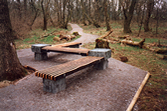
Charterhouse Centre - Mendip Hills
Area of Outstanding Natural Beauty Commemorative Bench
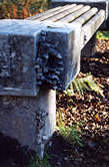
Click here to see larger images (61k)
Leigh on Mendip First School Entrance Arch
The School needed a sign, and wanted to enhance the main pedestrian entrance. After looking at the site, and talking to the teachers, governors, children and parents, a series of initial designs was made, which were shown to all interested parties, and from which elements were selected, and the final design evolved. The overall shape echoes other ironwork features in the village church, the mosaic is a reference to the Roman history of the area, the griffin is the Somerset County Council symbol, and the swallows are the school symbol. The children visited the forge to see the sign being made, and every child in the school contributed to the design, selection and making of two figurative mosaics - of a boy and a girl, which sit in two recesses on the reverse of the sign. Finally, the bars needed to fix the sign to the wall were drilled through and fixed with bolts whose ends were forged ammonites, visible on the outer wall - a reference to the rich geological history of Mendip. Pics: Gen + detail: School Entrance (Archway & Sign) Forged steel, galvanised and painted. Cement Tufa and glass mosaic. 3Metres high: 2 Metres wide.

Leigh on Mendip
First School Entrance Arch

Click
here to see larger images (63k)
Decorative Panel of pedestrian railings, Market Place, Frome.
Winner of 'sense of place' design competition for decorative panels for the Market Place railings, as part of Frome Town Centre Improvement Scheme. Forged and repousee steel, hot dip galvanised, patinated with etched gilding. The figurate head represents St Aldhelm, the founding father of Frome. On the reverse of the lettering panel appliqué silhouette represent trees and refer to the ancient forest of Selwood, where Aldhelm settled, and the town grew.
Bench for Woodland Trust Easy Access trail, Beacon Wood, Somerset.
Flame etched tanalised timber. Steel connecting bolts with forged ammonite heads. Each bench 2.1.metres long - backs 1.5 metres high. Table 60cm diameter with forged bronze ammonites fixed to a central core of marled sandstone/oolitic limestone bonded with cement.
Weathervane showing an eel about to swallow the local bait
- a ball of worms. The base contains a variety of local flora and fauna particular to the wetlands of the Somerset levels. This piece is part of the River Parret Trail, made for Somerset County Council. Forged steel, galvanised and painted. 1.8 metres high : 1.2.metres across.
'Artefacts in the Landscape' scheme at Bath City Farm
"Seating and Eating"
To create a new and durable public seating and eating Artefact, with the local community during the latter part of the summer 2000 school holidays. As this is the first in a series of projects aimed at revitalising Bath City Farm, great emphasis was placed on the work being accepted by the local, and larger Bath Community.
The project was seen as a first step - something manifest that would encourage a wider involvement and enable future funding to be sought for ongoing developments.
The project remit was to encourage and enable open access to all stages of design, making and installation, and to actively involve and gain the support of the local community, which included sensitively approaching local members of commerce/industry and the media with a view to long term help and support.
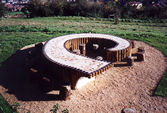
Bath City Farm: Eating
& Seating Project
From the outset, I was very aware of the short time scale allocated for the project, and in order to satisfy the requirements of both the funding brief, and Bath City Farms needs, I decided to pre-empt any selection problems that could have arisen by producing a standby design concept acceptable to Bath City Farm, prior to the consultation day. This allowed us to be sure of at least one finished proposal, designed to include community involvement, as well as to prepare to both cost out, and seek possible sponsorship from the outset. This proved prudent, as the consultation day, although well attended, did not generate any specific design initiatives.
The work is a mixed media piece, made essentially of timber and Bath stone cement fondue. The seating was affected by using oak rounds which have been carved with a chainsaw and secured into the ground around the edges of the spiral form of the table itself.
The outer edge of this table is made of tanalised round timbers, driven into the ground in the shape of a gentle and open ammonite helix. The shape defined by the posts was lined with goetextile and filled with hardcore prior to casting a structural concrete top, which included a cantilevered soffit that extended the tabletop to allow easy wheelchair access.
Local residents, mainly children, were encouraged and supervised to design and make decorative clay moulds into which coloured cement fondue and stone dust was cast. These motifs and plaques were then inset into the final hand applied top surface of the table.
Spiral motifs reminiscent of wrought iron scrollwork were burnt into the wooden sides of the table with a small flame, prior to an anti-graffiti coating being applied.
The chosen design was a challenging project to undertake given the time and physical constraints of the site, and the minimal amount of local adult support which was forthcoming. In spite of this, the end result is well liked and much used by local people, as well as being satisfying for the artists, Bath City Farm, and the many young helpers involved in its creation.
